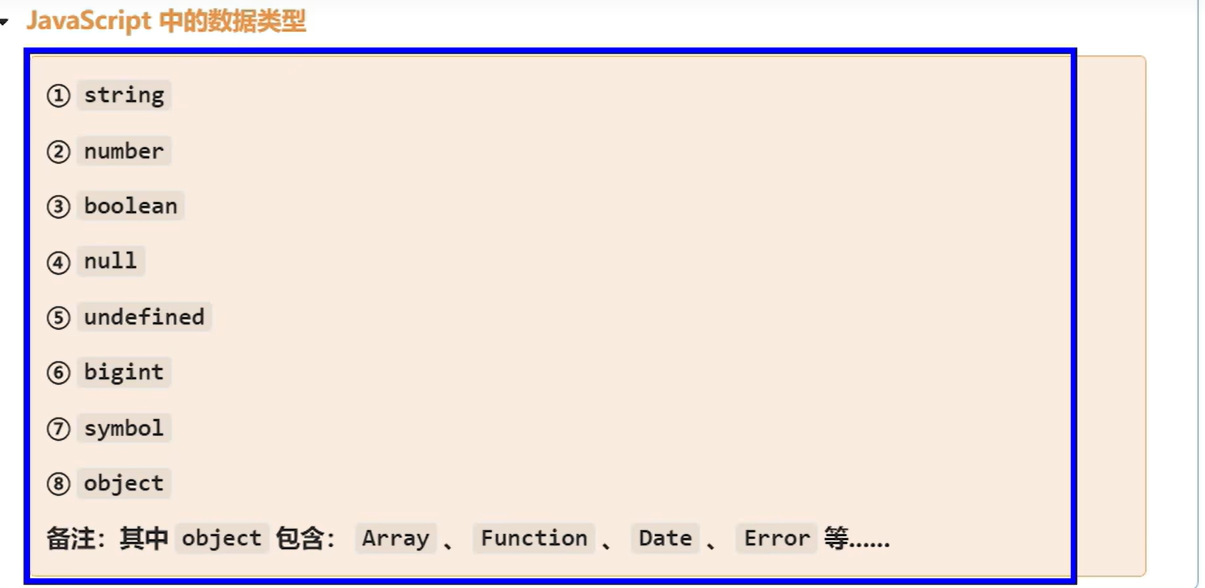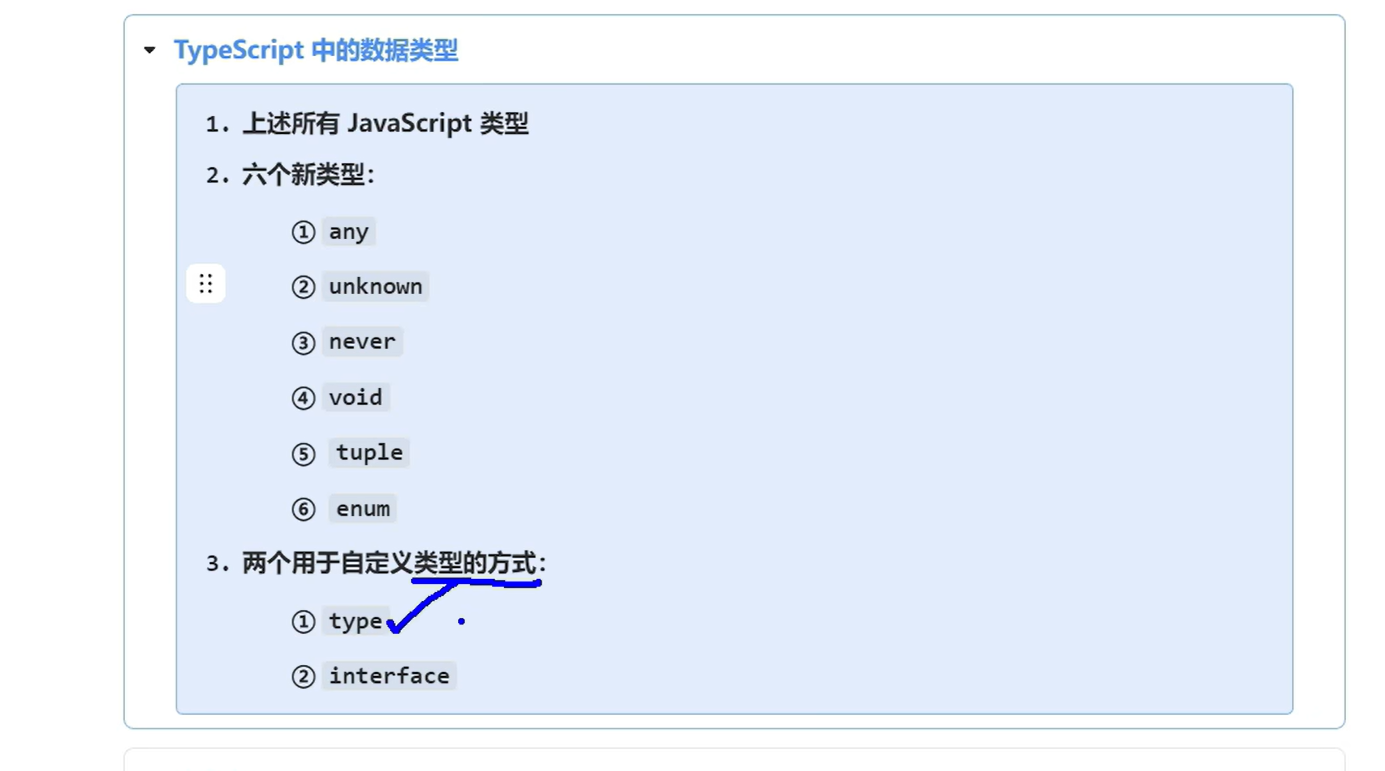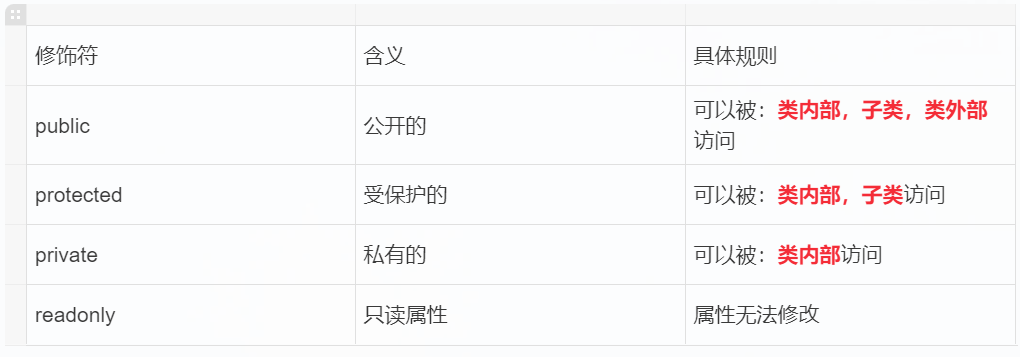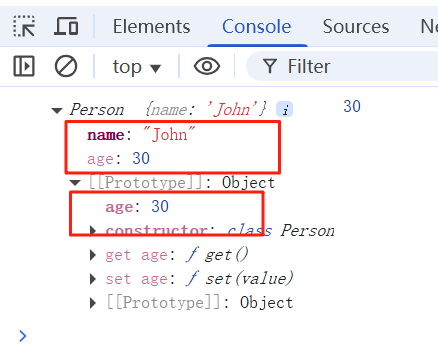一、视频资料
禹神:三小时快速上手TypeScript,TS速通教程_哔哩哔哩_bilibili
1 ts介绍
- ts
静态代码检查,—运行前进行检查,简言之:把运行时的错误前置
2.ts编译:
浏览器是不能直接运行ts代码,需要编译为js再由浏览器解析
两种编译方式
1.命令行编译
npm i typescript -g
就可以执行tsc了
tsc helloworld.ts
就可以把helloworld.ts转化成js了,直接引入js就可以运行了
缺点:是每次更改都需要在编译
2.自动化编译
tsc --init
生成一个tsconfig.json配置文件—后期配置这个就行
{
// Visit https://aka.ms/tsconfig to read more about this file
"compilerOptions": {
// File Layout
// "rootDir": "./src",
// "outDir": "./dist",
// Environment Settings
// See also https://aka.ms/tsconfig/module
"module": "es6",
"target": "es6",
"types": [],
// For nodejs:
// "lib": ["esnext"],
// "types": ["node"],
// and npm install -D @types/node
// Other Outputs
"sourceMap": true,
"declaration": true,
"declarationMap": true,
// Stricter Typechecking Options
"noUncheckedIndexedAccess": true,
"exactOptionalPropertyTypes": true,
// Style Options
// "noImplicitReturns": true,
// "noImplicitOverride": true,
// "noUnusedLocals": true,
// "noUnusedParameters": true,
// "noFallthroughCasesInSwitch": true,
// "noPropertyAccessFromIndexSignature": true,
// Recommended Options
"strict": true,
"jsx": "react-jsx",
"isolatedModules": true,
"noUncheckedSideEffectImports": true,
"skipLibCheck": true,
}
}
监视自动编译就使用:如果要针对某个文件就直接在后面加文件名,不加的话就默认全部js文件
tsc --watch
当然后期vue,react这种就直接开箱即用,不用自己配置
- tsc --help 可以查找他的mingling
3.语法


注意:
1.小写的string和大写的区别–string,number,boolean同理–推荐使用string小写的
- new String就是对象,会占用内存比简单数据类型
let str1:string
str1 = "hello world"
str1 = new String("hello world") // 这里报错,就是因为string这种只能赋值string这种原始类型,不能包装对象中的这种写法
console.log(str1)
let str2:String
str2 = "hello world"
str2 = new String("hello world") // 这里正常
console.log(str2)
二 常用类型
1.any
- 尽量不用any,要不用ts也没有意义了
- any有个坑就是可以赋值给任意类型eg下面这种不报错
let str1:string
let num1:any = 11
str1 = num1
console.log(str1)
2.unknown
- unknown :未知类型
- unknown 可以理解为一个类型安全的any,适用于不确定的具体类型
针对any示例, 变成unknow就不行了,下面这种str1就飘红了
let str1:string
let num1:unknown = 11
str1 = num1
console.log(str1)
解决方式可以断言
str1 = num1 as string
或
str1 = <string>num1
3.never
- never的含义是:任何值都不是,简而言之就是不能优质,undefined,null,‘’,0都不行
- 所以
1.不用never去限制任何变量,因为没有意义
2.never主要是用于那种永远不会用到的时候,eg
function getNum():never {
throw new Error('Function never returns')
}
3.永远不会走到的时候。ts主动推断出来的是never
let str:string="hello world"
if (typeof str==="string") {
console.log(str.toUpperCase());
} else {
console.log(str); // 默认str是never,就相当于永远不会走到
}
4.void
- void是针对
函数的,不写return的(不写其实有隐式的return undefined),也可以写return undefined,但是不能针对函数返回值哪怕是undefined做任何操作
5.object
- 关于object(array,function都可以),和Object(能.toString()的都可以赋值,string都行,比object限制的范围还大,其实就是除了null和undefined,跟any差不多) 范围太大,实际开发中不使用
- 1.声明对象类型
let obj:{ name: string, age?: number, [key:string]: any } = {
name: '张三',
lalal: 'lalal',
lulul: 'lulu'
}
- 2.声明函数类型
let count: (a: number, b: number) => number
count = (a, b) => {
return a + b
}
//函数声明法
function run():string{
return '123'
}
//匿名函数
var fun2 = function():number{
return 123
}
// 多个参数
function sum(a:number, ...result:number[]):number{
var sum = 0;
for(var i=0; i<result.length;i++){
sum+=result[i]
}
return sum
}
alert(sum(1,2,3,4))
- 3.声明数组类型
let arr1:string[] = ['a','b','c'];
let arr2:Array<string> = ['a','b','c'];
6.元祖tuple
- 元祖是一种特殊的数组类型
let arr1:[string, number] = ['hello', 1];
let arr2: [string, number?] = ['hello'];
let arr3: [string, ...number[]] = ['hello', 1, 2, 3]; // 可以有无线多个数字类型
7.枚举enum
- 1.枚举主要解决的问题是比如以下这种情况可能在定义函数里面left等
拼错,或者调用时候有人拼错
function walk(str: string) {
if (str === 'up') {
console.log('向上走')
} else if (str === 'left') { // 这里说不准会拼错
console.log('向左走')
} else {
console.log('向下或者向右走')
}
}
walk('la') // 这里可能会传的拼错
为了解决此问题可以使用enum
enum Direction {
up,
down,
left,
right
}
function walk(str: Direction) {
if (str === Direction.up) {
console.log('向上走')
} else if (str === Direction.left) {
console.log('向左走')
} else {
console.log('向下或者向右走')
}
}
walk(Direction.up)
- 2.如果是直接打印Direction,里面这个有映射和反映射,从0开始的,如果你不想从0开始可以, 当然也可以是字符串就是没有反映射了
enum Direction {
up,
down,
left,
right
}
console.log(Direction)
enum Direction {
up,
down = 3,
left,
right
}
console.log(Direction)
enum Direction {
up = "up",
down = "sjhshjs",
left = "sdasfd",
right = "asdas"
}
console.log(Direction)
对应的打印

- 3.注意的点
enum Direction {
up,
down,
left,
right
}
console.log(Direction.up);
上面这种写法会编译成以下这种,我枚举的这些,但是真正使用只有up,现在都给我编译出来了
"use strict";
var Direction;
(function (Direction) {
Direction[Direction["up"] = 0] = "up";
Direction[Direction["down"] = 1] = "down";
Direction[Direction["left"] = 2] = "left";
Direction[Direction["right"] = 3] = "right";
})(Direction || (Direction = {}));
console.log(Direction.up);
//# sourceMappingURL=index.js.map
如果想改变就加一个const ----当然ts配置中
"preserveConstEnums": false,
ts
const enum Direction {
up,
down,
left,
right
}
console.log(Direction.up)
编译的js
"use strict";
console.log(0 /* Direction.up */);
//# sourceMappingURL=index.js.map
8.type
- type可以理解为别名
- 1.可以定义多重类型
type Status = number | string;
const aaa: Status = 200
const bbb: Status = '200'
type Status = '男' | '女';
const aaa: Status = "女" // 只能写男或者女了
- 2.联合类型
type Area = {
height: number,
width: number
}
type Position = {
x: number,
y: number
}
type Rectangle = Area & Position
// 联合类型,得同时有满足Area和Position里面的值
const rectangle: Rectangle = {
height: 10,
width: 20,
x: 5,
y: 5
}
- 3.一种特殊情况
function demo():void{
console.log('demo');
return '111' // 报错
};
换成这种形式写法就不报错了,ts并不会严格要求函数返回为void
type logFunc = ()=>void;
const demo:logFunc = function (){
console.log('demo');
return '111' // 就不报错了
};
原因官网有解释就是为了foreach等函数内部只有一行的时候可以省略{},要不省略了自动就是return了,都报错那就比较麻烦了,但是你拿到这个返回值后期也不能做任何操作
9.复习类相关知识
1.类
class Person {
name: string
age:number
constructor(name: string, age: number) {
this.name = name
this.age = age
}
speak() {
console.log(`我的名字${this.name},年龄${this.age}`) // 我的名字ZHAO,年龄18
}
}
const p = new Person('ZHAO', 18)
p.speak()
2.继承类
class Person {
name: string
age:number
constructor(name: string, age: number) {
this.name = name
this.age = age
}
speak() {
console.log(`我的名字${this.name},年龄${this.age}`)
}
}
class Student extends Person{
grade: string
constructor(name: string, age: number, grade: string) { // 如果不多加属性就不用constructor了
super(name, age)
this.grade = grade
}
study() {
console.log(`${this.name}正在努力学习中`)
}
override speak() { // 想重载最好写上override, 不写也行,写上避免拼错这个函数名speak
console.log(`wodenianji${this.grade}`)
}
}
const s = new Student('LALA', 18, '高一')
s.speak() // wodenianji高一
3.类的修饰符
都可以即修饰属性,又可以修饰方法

- 1.public其实你不写默认就是public-主要看那里是内部,外部,子类
class Person {
public name: string
public age:number
constructor(name: string, age: number) {
this.name = name
this.age = age
}
public speak() { // 在Person里面的这些都是类的内部
console.log(`我的名字${this.name},年龄${this.age}`)
}
}
// 子类中访问
class Student extends Person {
public study() {
console.log(`我正在学习第${this.name}年级`)
}
}
// 这里就是外部访问
const p = new Person('张三', 18)
p.name
- 2.属性的简写形式
原写法
class Person {
public name: string
public age:number
constructor(name: string, age: number) {
this.name = name
this.age = age
}
}
const p = new Person('Tom', 18)
console.log(p.name)
简化后—记得一定要写修饰符,只要简写就得用修饰符
class Person {
constructor(public name: string, public age: number) {} // 注意这里需要写上public哦
}
const p = new Person('Tom', 18)
console.log(p.name)
以下就使用简写形式写了哈, 都同理
直接看readonly吧
class Person {
constructor(
public name: string,
public readonly age: number
) {}
}
const p = new Person('Tom', 18)
p.name = 'zhaohui'
p.age = 19 // 这里就报错了
static
class Person{
static sex="男"
static print(){
alert('111'+Person.sex)//这里面就没法直接用this了,没法调用类里面的属性,如果想要用,就定义一个静态属性,但是不用this昂
}
}
Person.print()
10.抽象类
- 抽象类
不能实例化new *** - 主要意义是
被继承,抽象类里面可以有通用方法或属性,也可以抽象方法(相当于制定规则,后期必须有此方法及实现)
eg 快递有标准快递,有特快快递
abstract class Package {
constructor(public weight: number) {}
// 抽象方法,计算运费, 后期继承的必须要有这个方法
abstract getCost(): number;
// 具体实现
print() {
console.log(`运费为:${this.getCost()}`);
}
}
// 普通快递
class NormalPackage extends Package {
// 这里的public或其他修饰符必须写呦-简写属性必须写修饰符,别忘了
constructor(weight: number, public unitPrice: number) {
super(weight);
}
getCost(): number {
return this.weight * this.unitPrice;
}
}
// 快件
class FastPackage extends Package {
// 要是没有多余属性就不用写constructor
getCost(): number {
return this.weight *100;
}
}
const normalPackage = new NormalPackage(10, 5);
normalPackage.print(); // 运费为:50
const fastPackage = new FastPackage(10);
fastPackage.print(); // 运费为:1000
// const package = new Package(10); // 报错,因为不能new 抽象类
11.interface接口
interface是定义结构的一种方式,主要用于
类,对象,函数等规定的一种契约。注意的是接口是只能定义格式,不能包含任何实现。对于项目中类,对象等无脑冲这个接口就行,项目中经常用到的就是接口1.定义类结构
interface PersonInterface {
name: string;
age: number;
sing(): void;
}
class Person implements PersonInterface {
constructor(public name: string, public age: number) {}
sing() {
console.log("I am singing");
}
}
- 2.对象
interface UserInterface {
name: string;
email?: string;
readonly password: string;
run(): void;
}
const user: UserInterface = {
name: "John",
password: "123",
run() {
console.log("run");
},
};
- 3.函数
interface CountInterface {
(a: number, b: number): number;
}
const count: CountInterface = (a, b) => {
return a + b;
};
- 4.接口有继承
interface PersonInterface {
name: string;
age: number;
}
interface StudentInterface extends PersonInterface {
grade: string;
}
const student: StudentInterface = {
name: "John",
age: 16,
grade: "A",
};
- 5.接口的自动合并(相同名字)
interface PersonInterface {
name: string;
age: number;
}
interface PersonInterface {
grade: string;
}
const student: PersonInterface = {
name: "John",
age: 16,
grade: "A",
};
12.interface和type的区别
- 相同点: interface和type都可以定义对象,很多情况下可以直接互换的
- 不同点
- interface:更专注于定义对象和类的结构,支持继承,合并
- type:可以定义类型别名,联合类型,交叉类型,不可以继承和合并
13.interface和抽象类的区别
- 相同点:都用于定义类的格式
- 不同点:
- 接口:只能描述结构,不能有任何实现。一个类可以实现多个接口
- 抽象类:既可以包含抽象方法,也可以包含具体实现。一个类只能继承一个抽象类
// 类可以实现多个接口
interface FlyInterface {
flyIn(): void;
}
interface SwimInterface {
swimIn(): void;
}
class Bird implements FlyInterface,SwimInterface {
flyIn() {
console.log('I can fly');
}
swimIn() {
console.log('I can swim');
}
}
14.泛型
- 我觉得就想一个
变量,比如定义函数的时候我确实不知道传什么参数,只有在使用的时候才规范参数
eg - 1.泛型函数
function logData<T, U>(data:T, data2: U): T|U {
return Date.now() % 2 === 0 ? data : data2
}
logData<number, string>(1, '2')
logData<string, boolean>('1', false)
- 2.泛型接口
interface PersonInterface<T> {
name: string;
age: number;
skills: T;
}
const person1: PersonInterface<string[]> = {
name: "Mike",
age: 30,
skills: ["JavaScript", "TypeScript"],
};
const person2: PersonInterface<{ skill: string }> = {
name: "Mike",
age: 30,
skills: { skill: "JavaScript" },
};
const person3: PersonInterface<number> = {
name: "Mike",
age: 30,
skills: 1,
};
type JobInfo = { job: string };
const person4: PersonInterface<JobInfo> = {
name: "Mike",
age: 30,
skills: { job: "Developer" },
};
- 3.泛型类
class Person<T> {
constructor(public name: T, public age: number) {}
}
const p = new Person<string>('Tom', 18);
15.类型声明文件
.d.ts文件,主要为现有的js代码提供类型信息,使得ts能都对这些js做类型检查和提示
比如一个js文件先写了
moni.js
export function add(a, b) {
return a+b
}
然后再ts中使用,没有类型提示,所以就
moni.d.ts
declare function add(a: number, b: number): number;
export { add };
就有提示了
16.装饰器
- 装饰器就是一种
特殊的函数-可以理解为给类,属性等添加一些方法或属性啥的 - 装饰器是一个
实验性质的特性,需要更改配置。ts5.0可以直接用类装饰器,不用改配置,其他的不保证 - 装饰器有5中:
类装饰器,属性。。。,方法,,,访问器,,,参数。。。
// 启用装饰器支持
"experimentalDecorators": true,
// 启用装饰器元数据支持(可选)
"emitDecoratorMetadata": true,
1.类装饰器
/**
*
* @param target: 就是Person类
*/
function CustomString(target: Function) {
target.prototype.toString = function () {
return JSON.stringify(this);
}
}
@CustomString
class Person {
constructor(public name: string) {
this.name = name;
}
}
const p = new Person('Jane');
console.log(p.toString()) // [object Object],有装饰器后{"name":"Jane"}
关于返回值如果装饰器中返回一个类,就会替换被装饰的类
function demo(target: Function) {
return class {
run() {
console.log('run')
}
}
}
@demo
class Person {
test() {
console.log('test')
}
}
console.log('Person', Person) // 打印的是那个run的类
关于构造类型Funtion 这个类型比较宽泛,包括:普通函数、箭头函数、构造函数等等,我想只让传可以new的构造函数,定义这么写
// 单独定义构造函数
type Constructor = new (...args: any[]) => any;
function test(fn: Constructor) {}
class Person{}
test(Person);
// 定义构造函数,并且里面有个wife静态属性
type Constructor = {
new (...arg: any[]): {};
wife: string
};
function test(fn: Constructor) {}
class Person{
static wife: 'mama'
}
test(Person);
替换被装饰的类
给这个类属性加一个属性,和方法
type Constructor = new (...args: any[]) => {}
// 要么下面调用getTime 报错
interface Person {
getTime():void
}
function logTime<T extends Constructor>(target: T) {
return class extends target {
createTime: Date
constructor(...args: any[]) {
super(...args);
this.createTime = new Date();
}
getTime() {
return `创建时间为${this.createTime}`
}
}
}
@logTime
class Person {
constructor(public name: string) {}
greet() {
console.log(`Hello, my name is ${this.name}`);
}
}
const p = new Person('Jane');
console.log(p, p.getTime())

2.装饰器工厂
- 可以理解为装饰器工厂可以接收
自定义参数,然后返回一个装饰器 - eg,传入几就打印几次
function logInfo(num: number) {
return function(target: Function) {
target.prototype.introduce = function() {
for(let i = 0; i < num; i++) {
console.log(`I am ${this.name}`);
}
}
}
}
interface Person {
introduce():void
}
@logInfo(3)
class Person {
constructor(public name: string) {}
}
const p = new Person('Jim');
p.introduce() // 调用一次就可以打印三次了
3.装饰器组合
如果有装饰器,又有装饰器工厂,那么执行顺序是从上往下先执行工厂函数,然后再从下往上执行装饰器
function test1(target: Function) {
console.log('test1装饰器')
}
function test2() {
console.log('test2装饰器工厂')
return function (target: Function) {
console.log('test2装饰器')
}
}
function test3() {
console.log('test3装饰器工厂')
return function (target: Function) {
console.log('test3装饰器')
}
}
function test4(target: Function) {
console.log('test4装饰器')
}
@test1
@test2()
@test3()
@test4
class Test {}
// 执行顺序
// test2装饰器工厂
// test3装饰器工厂
// test4装饰器
// test3装饰器
// test2装饰器
// test1装饰器
4.属性装饰器
先了解taget的不一样
// target 如果是普通类属性就是指类的原型对象, 如果是静态属性,target就是类
// propertyKey就是属性名
function Demo(target: any, propertyKey: string) {
console.log(target, propertyKey);
}
class Person {
@Demo name: String;
@Demo static age: Number;
constructor(name: String) {
this.name = name;
}
}
关于属性遮蔽问题
- 比如new 实例在上面,Object.defineProperty在下面,肯定就是先往自己属性放个age30,再在原型上放age110
- 如果相反,比如先往原型上放个age110,在new往属性上加个age30,它会先顺着原型链找,找到都更改了
class Person {
constructor(public name: string, public age: number) {}
}
const person = new Person('John', 30);
let ageValue = 110
Object.defineProperty(Person.prototype, 'age', {
get() {
return ageValue
},
set(value) {
ageValue = value;
}
})
console.log(person, person.age);

class Person {
constructor(public name: string, public age: number) {}
}
let ageValue = 110
Object.defineProperty(Person.prototype, 'age', {
get() {
return ageValue
},
set(value) {
ageValue = value;
}
})
const person = new Person('John', 30);
console.log(person, person.age);

应用: eg: 监视属性的修改
在修改name的时候先打印一下,
function state(target: any, propertyKey: string) {
Object.defineProperty(target, propertyKey, {
get: function () {
return this['_' + propertyKey];
},
set: function (newValue) {
console.log('set ' + propertyKey + ' to ' + newValue);
this['_' + propertyKey] = newValue;
}
});
}
class Person {
@state name: string;
constructor(name: string) {
this.name = name;
}
}
const p = new Person('xiaoming'); // set name to xiaoming
p.name = 'llalalll' // set name to llalalll
5.方法装饰器
/**
*
* @param target 如果是类普通方法就是,target就是原型对象, 如果是静态方法,target就是类对象--同属性装饰器
* @param name 方法名 speak --同属性装饰器
* @param descriptor 方法描述对象
* @returns
*/
function demo(target:any, name:any, descriptor: any) {
console.log(target, name, descriptor);
return descriptor;
}
class Person {
@demo
speak() {
console.log("hello world");
}
static walk() {
console.log("walking");
}
}
应用: 在调用方法前和后写一下逻辑
function demo(target: any, propertyKey: string, descriptor: PropertyDescriptor) {
const original = descriptor.value;
descriptor.value = function(...args: any[]) {
console.log(`${propertyKey}开始调用`);
const result = original.apply(this, args);
console.log(`${propertyKey} 结束调用`,);
return result
};
}
class Person {
constructor(public name: string) {}
@demo greet(zhufun: string) {
console.log(`Hello, my name is ${this.name},祝福${zhufun}`);
}
}
const person = new Person('张三');
person.greet('天天开心');

6.访问器装饰器(get, set)和参数装饰器就应用不多了,后面遇到再看
17.模块和命名空间
模块,公共功能
比如模块,我新建一个文件夹modules, 里面建一个index.ts文件
里面暴露export
然后在需要的ts文件中引入,也用import就行,然后等运行,变成js的时候会变成es5的就是exports和require,因为浏览器不能识别,所以这边就可以用node来运行,方法就是
打开所在文件夹,进入到js文件中,然后输入命令 node index.js
这里面一定要注意js和ts昂
命名空间,命名空间可以做成模块的,也是可以export命名空间
namespace A{
}
namespace B{
这里面的名字和A里面的可以一样,不会造成命名冲突
这里面是私有的
如果在外面访问还是需要export暴露的呦,但是在外面就不需要import了
也可以不暴露,直接用B.Cat这种就行
eg
export class Dog {
}
class Cat{
}
}
var d = new Dog()
var c=new B.Cat()